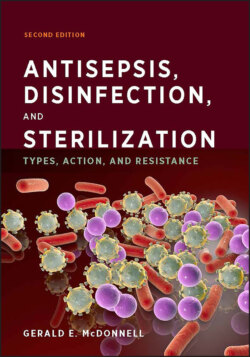Читать книгу Antisepsis, Disinfection, and Sterilization - Gerald E. McDonnell - Страница 18
1.3.3 Eukaryotes 1.3.3.1 MULTICELLULAR EUKARYOTES
ОглавлениеMulticellular eukaryotes include microscopic (or, indeed, macroscopic) arthropods and helminths (or worms). These are higher forms of life, composed of eukaryotic cells that are specialized into organs and structures. Arthropods are not considered further here, but some introduction is given to the helminths. Helminths are a diverse group of multicellular parasites and can be further classified as nematodes (roundworms) and platyhelminthes (flatworms). Over 20,000 species of nematodes have been defined, although it is estimated that 10 to 100 times this number possibly exist. The flatworms can be further separated into trematodes (flukes) and cestodes (tapeworms). Many helminths can be free-living in water environments (in particular, the roundworms), but most are parasitic in nature. Some of the key diseases caused by helminths are summarized in Table 1.4. Helminths reproduce sexually and have a typical associated life cycle (Fig. 1.1).
Externally, the adult forms (including worms and flukes) are protected by a rigid proteinaceous (collagen) cuticle, which can resist the effects of biocidal processes; however, parasitic forms will not survive in the environment without their respective hosts (including, in some cases, intermediate hosts). Further, during their respective life cycles they produce dormant forms (including ova [eggs] or cysts) that can survive under harsh environmental conditions. Little work has been published on the structure of these eggs and their relative resistances to biocides, but microscopically they are diverse, consisting of various proteins and carbohydrates and having a variety of thicknesses (see section 8.11).
TABLE 1.1 Examples of various types of microorganisms
| Microorganism | Typical structuresa | Size (μm) | Nucleic acid | Cell wall |
| Prions | <0.01 | None | No | |
| Viruses | 0.01–0.4 | DNA or RNA | No Envelope may be present | |
| Chlamydias, rickettsias | 0.3 | DNA | Minimal or simple cell wall | |
| Mycoplasmas | 0.1–0.3 | DNA | No | |
| Bacteria | 0.3–0.8 | DNA | Yes | |
| Fungi | Yeast, 8–10 Fungi, >0.5 (wide), >5 (long) | DNA | Yes | |
| Algae | 1 – >1,000 | DNA | Yes/no (some) | |
| Protozoa | 10–200 | DNA | No | |
| Helminths | >1,000 | DNA | NAb |
aNot to scale; simplified structures are shown. In addition, the basic structures of microorganisms can vary considerably based on their type, environmental conditions, and growth (or life cycle) phase.
bNA, not applicable.
TABLE 1.2 Some advantages and disadvantages of microorganisms
| Advantage or disadvantage | Example(s) |
| Advantages | |
| Food and beverage production | Saccharomyces cerevisiae: bread and beer production Saccharomyces ellipsoideus: wine fermentation |
| Antibiotic production | Bacillus licheniformis: bacitracin Penicillium chrysogenum: penicillin |
| Vitamin metabolism | Pseudomonas spp.: vitamin B12 production Escherichia spp.: vitamin K synthesis in the gut |
| Genetic engineering | Agrobacterium tumefaciens: plasmids used for generating transgenic plants (e.g., herbicide or pathogen resistance) |
| Disease prevention | Bacteroides, Enterococcus spp.: prevention of pathogen colonization of the intestinal tract |
| Bioremediation | Desulfotomaculum spp.: arsenic detoxification |
| Disadvantages | |
| Animal/human diseases | Mycobacterium spp.: tuberculosis HIV:AIDS Plasmodium spp.: malaria |
| Plant diseases | Phytophthora: potato blight Corynebacterium: vegetable infections |
| Surface damage | Pseudomonas spp.: biofilm development and surface corrosion |
| Food spoilage | Rhizopus: bread mold Streptococcus: milk souring |
| Allergic reactions | Fungal spores, including Aspergillus spp. |
| General product contamination | Bacterial and fungal spores, including Bacillus spp. |
